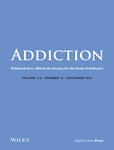Studies show that higher levels of positive affect (PA) and lower levels of negative affect (NA) are related to craving and alcohol consumption at a daily level in men, but little is known on these associations at a momentary level, and whether they are present in women. This study measured the dynamics of within-person NA and PA surrounding craving, non-heavy alcohol use and binge drinking in women with alcohol use disorder (AUD) and female controls without AUD.
53 female patients with AUD and 75 female controls, all recruited in Belgium, were included in an experience sampling study where they reported on momentary NA, PA, craving and alcohol use in daily life over a period of 12 months. Assessments occurred eight times a day on Thursdays, Fridays and Saturdays in seven bursts of three weeks.
Within-person NA at a previous assessment (t−1) predicted craving at the current assessment (t0) in patients with AUD in a positive linear [β = 0.043; 95% confidence interval (CI) = 0.002, 0.057; P = 0.041] and quadratic fashion (β = 0.034; CI = 0.011, 0.057; P = 0.004). Within-person PA at t−1 predicted craving at t0 in patients with AUD with a positive quadratic relation (β = 0.042; CI = 0.08, 0.065; P < 0.001). Within-person NA at t−1 negatively predicted non-heavy alcohol use at t0 in a linear fashion in controls (β = −0.495; CI = -0.677, -0.312; P < 0.001) and patients with AUD (β = −0.276; CI = -0.421, -0.132; P < 0.001). Within-person PA at t−1 significantly predicted non-heavy alcohol use at t0 with a positive linear term (β = 0.470; CI = 0.329, 0.610; P < 0.001) in controls, but with a positive linear term (β = 0.399; CI = 0.260, 0.454; P < 0.001) and a positive quadratic term (β = 0.203; CI = 0.060, 0.347; P = 0.003) in patients with AUD. Within-person NA at t−1 predicted binge drinking at t0 in patients with AUD with a significant quadratic term (β = 0.236; CI = 0.060, 0.412; P = 0.008), but not for controls. Within-person PA at t−1 predicted binge drinking at t0 in patients with AUD with a significant quadratic term (β = 0.378; CI = 0.215, 0.542; P < 0.001), and this was also the case for controls (β = 0.487; CI = 0.158, 0.770; P < 0.001). Non-heavy alcohol use at t0 predicted lower levels of NA at t+1 in both patients with AUD (β = −0.161; SE = 0.044; CI = -0.248, 0.074; P = 0.001) and controls (β = −0.114; CI = -0.198, -0.029; P = 0.010). Non-heavy alcohol use at t0 also predicted higher levels of PA at t+1 in both patients with AUD (β = 0.181; CI = 0.088, 0.274; P < 0.001) and controls (β = 0.189; CI = 0.101, 0.278; P < 0.001).
The momentary relation between affect and craving or alcohol use seems to be non-linear in female patients with alcohol use disorder, whereby a worse mood predicts subsequent alcohol use, though more for binge drinking than for non-heavy alcohol use.


